5 Topic 4.1. Introduction to Niche-based ecological Models
Viedo #1: The concept of ecological niche:
Viedo #2: Impacts of climate change and species occurrence based niche modeling:
Viedo #3: Provenance trials based niche modeling:
Contents
1. Adaptation of plant species to climate
2. Ecological niche
2.1. Fundamental niche
2.2. Realized niche
2.3. Niche conservatism
3. Impacts of climate change on ecological niche
3.1. Niche shift
3.2. Mismatch at the population level
4. Climatic niche modeling
4.1. Occurrence data-based modeling
4.2. Provenance trials-based modeling
1. Adaptation of plant species to climate
Of many environmental elements, the climate is the primary factor regulating geographic distributions of plant species. The climate was relatively stable over the last 10,000 years (Figure 1). This period started at around -8500 A. D. after the last Ice Age. This provided an opportunity for plant species to evolve and migrate to geographic locations where climatic conditions are suitable for them to survive, grow and reproduce.
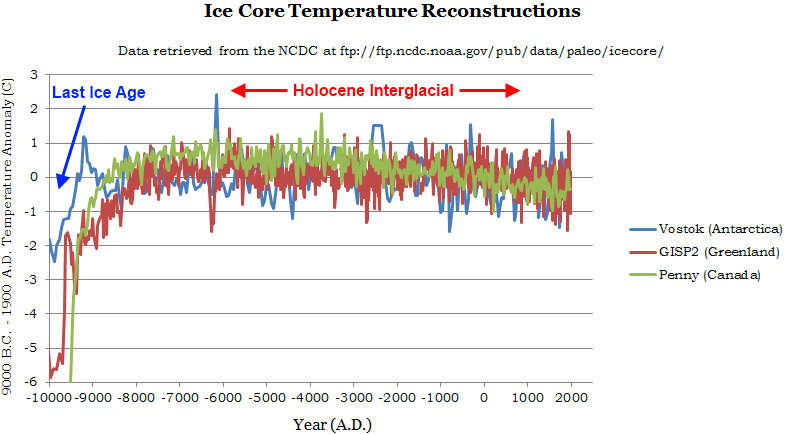
Through long-term evolution and selection, plant species are adapted to a certain range of climatic conditions over the globe. Species that adapted to similar climatic conditions are grouped into biomes (Figure 2). It clearly shows that different climates support different biomes. For example, the tropical climate supports tropical rainforests, while boreal forests distribute in cold climates in the north.
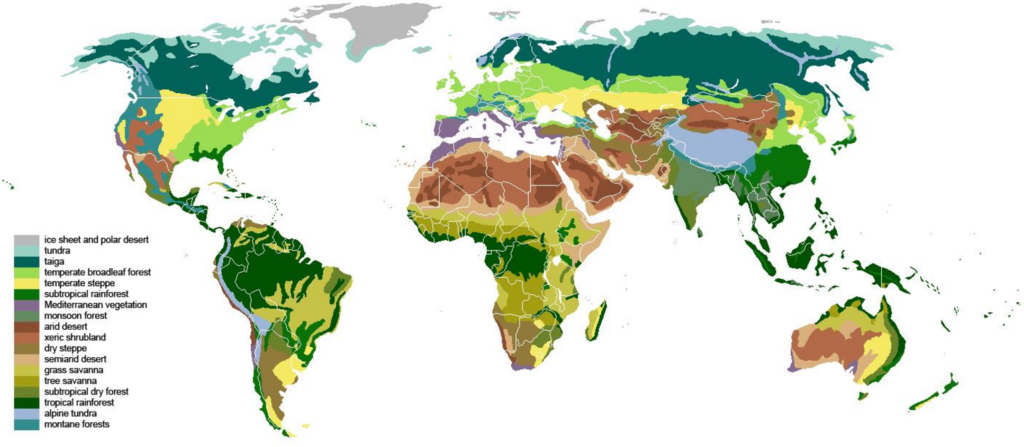
At the species level, each species is adapted to a certain range of climatic conditions (Figure 3). For example, in North America, Douglas-fir is adapted to western North America up to the middle of British Columbia, while spruce and jack pine are distributed further north under a cooler climate. In China, Chinese fir is adapted to a warm and wet climate in the south, while Chinese pine is distributed in the north and northwest adapted to a cool and dry climate.
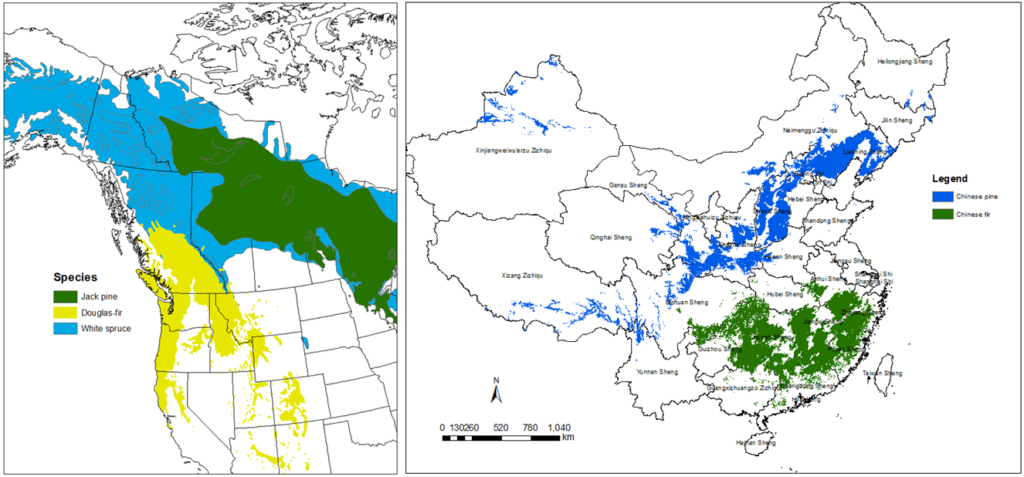
2. Ecological niche
For a species to maintain its population, its individuals must survive and reproduce. Certain combinations of environmental conditions are necessary for individuals of each species to tolerate the physical environment, obtain energy and nutrients, and avoid predators. The total requirements of a species for all resources and physical conditions determine where it can live and how abundant it can be at any one place within its range. These requirements are termed abstractly the ecological niche.
An ecological niche is originally defined as the position of a species within an ecosystem, describing both the range of conditions necessary for the persistence of the species and its ecological role in the ecosystem. An ecologist, G.E. Hutchinson (1957), suggested that the niche could be modeled as an imaginary space with many dimensions, in which each dimension or axis represents the range of some environmental condition or resource that is required by the species, as illustrated in Figure 4. Hutchinson’s definition of ecological niche formed the basis of niche-based ecological models.

Climate is the most important environmental factor determining species distribution. When only climatic components are considered in studying the ecological niche of a species, the ecological niche is also called a climatic niche. The term climatic niche is widely used in ecological modeling related to climate change.
2.1. Fundamental niche
A fundamental niche is the full range of (physical) environmental conditions that a species can occupy and use, without any other limiting factors present which could constrain the population. In other words, the fundamental niche is the potential niche that the species could occupy if there were no limiting factors. Within its fundamental niche, a species can survive, grow, regenerate and evolve.
2.2. Realized niche
A realized niche is the range of conditions actually occupied by a given species. In the real world, a species can only occupy a part of its fundamental niche because of limiting factors, such as competitors, parasites, disease, and physical barriers. Among all the limiting factors, interspecies competition is considered the most important one. Thus, sometimes fundamental niche and realized niche are termed precompetitive and postcompetitive niches, respectively. The difference between a fundamental niche and a realized niche is shown in Figure 5.

The realized niche of a species is reflected by its geographical distribution over the landscape. For example, lodgepole pine is distributed in western North America as shown in Figure 6. Through determining the climatic conditions of the geographic areas occupied by the species, the realized niche for this species can be defined as shown in Figure 7.
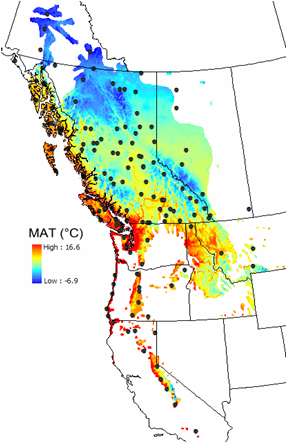
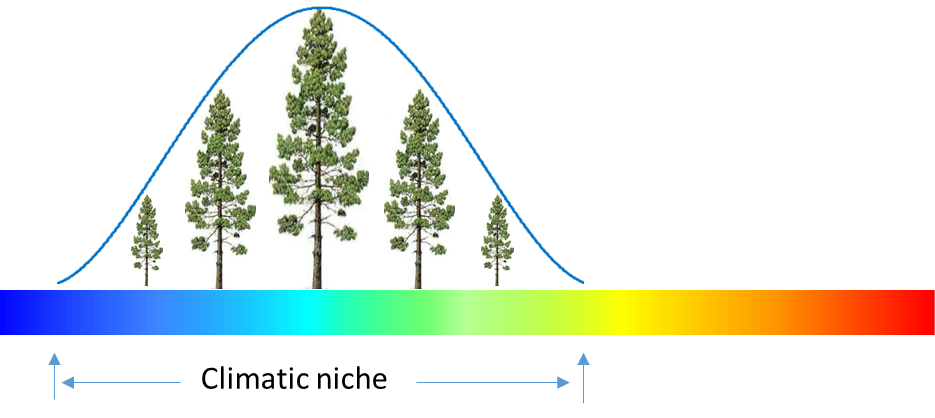
2.3. Niche conservatism
Many aspects of the fundamental niche can be conserved over long evolutionary timescales. The tendency of species to retain aspects of their fundamental niche over time is called niche conservatism.
Although debate exists in the literature regarding niche conservatism, the evidence is overwhelming in favor of this theory. Many congeneric plant species in Europe and North America had similar geographic ranges on each continent, a pattern interpreted as evidence for niche conservatism. Niche conservatism is observed in six environmental variables in a sample of more than 1000 species of higher plants in Europe.
Niche conservatism is important because of its relevance to predicting species’ responses to global change. A tendency toward conservatism would mean that species have only a limited capacity to adapt to new environmental conditions.
3. Impacts of climate change on ecological niche
3.1. Niche shift
Climate change is shifting the climatic niche away from the currently occupying geographic locations. Due to the long lifecycle and slow rate of migration of forest trees, such a shift is causing a mismatch between the climate that the species is adapted to and the climate that the species will experience in the future (Figure 8). This is probably the most important challenge for forest species to adapt to a changing climate.

As a result, trees left out of their climate niche will be suffering from sub-optimal climatic conditions and become vulnerable to insects (Figure 9), diseases, and other hazards. This will likely be the case for existing forests in the lagging areas of the species’ climatic niche. Aspen dieback might be an example of the climate niche mismatch (Figure 10).
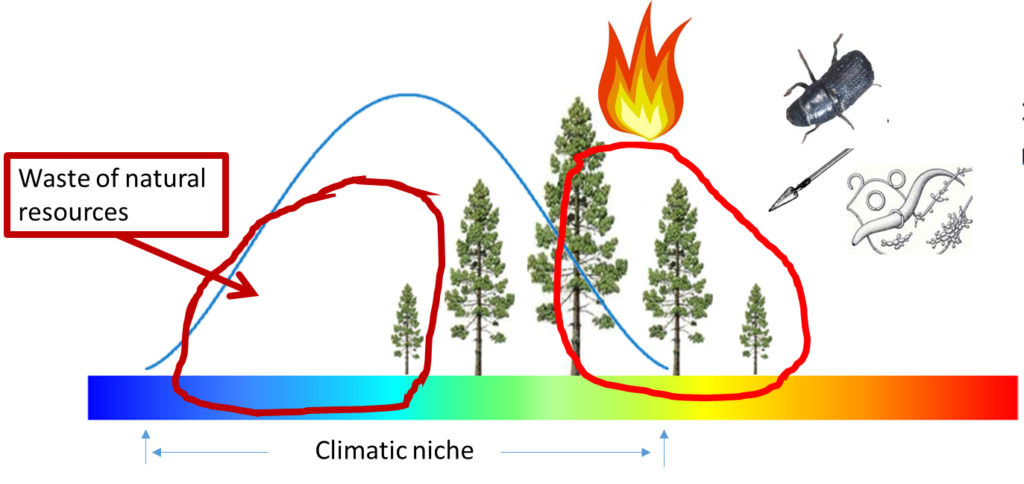
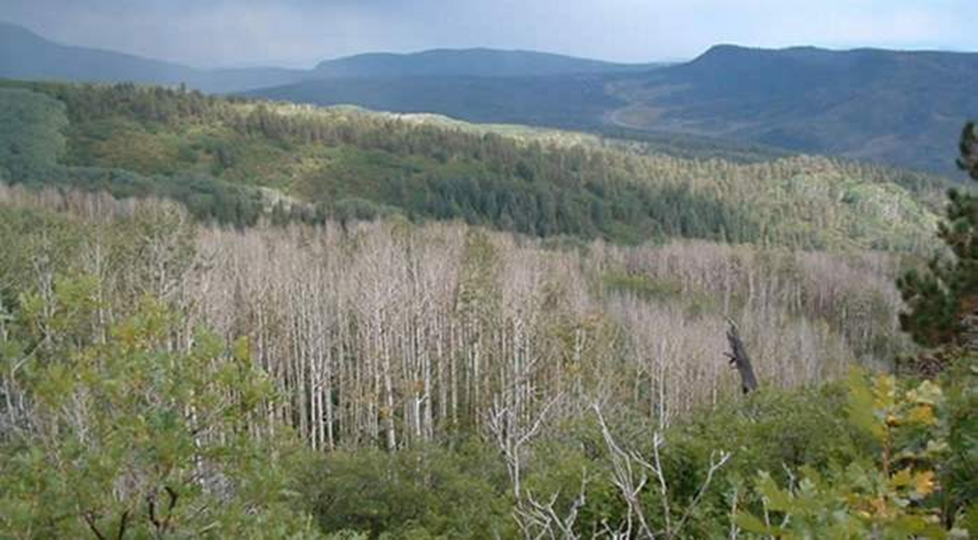
On the other hand, some areas may become suitable for the species, but it may need a long period for the species to be able to migrate there. Thus, the potential of these areas is not to be used for a long time if we completely rely on the migration of the species on its own.
3.2. Mismatch at the population level
As shown in Figure 11, climatic mismatches occur in two dimensions. One is the mismatch in a climatic niche at the species level (horizontally), and another is the mismatch at the population level (vertically). Due to the geographical shift in the climatic niche, some populations will be left out of the climatic niche of the species as discussed previously. Even for populations that remain within the climate niche, they are no longer under their optimal climate conditions. Survival may not be a problem, but productivity may be compromised. The mismatches in both dimensions need to be considered for developing forest adaptive strategies.

A climatic niche model is to model or define the climatic niche of a given species and to predict its geographic distribution for different climatic conditions, including future climate projections.
4.1. Species occurrence-based modeling
A climatic niche model can be built based on the relationship between the geographical occurrence of a species and its corresponding climatic variables (Figure 12a). Such a model reflects the realized niche of the species (Figure 12b) because the species occurrence is the result of not only the environmental conditions but also migration, local adaptation, and interactions with other species and organisms under recent/historical climatic conditions. The models of this form are typically referred to as climatic niche models, bioclimatic envelope models, or ecological niche models. These terms are often used interchangeably. Occurrence data-based climatic niche models are widely used because the occurrence data is probably the easiest to obtain for a plant species, and models’ prediction accuracies are reasonably high. Species occurrence-based models are analytical models, as discussed previously.
Climatic niche models are widely called correlative species distribution models (SDMs). However, as a climatic niche model defines and predicts the suitable climatic habitat rather than the actual distribution of a species, which involves a series of evolutionary and ecological processes. Therefore, a climatic niche model is, strictly speaking, not a species distribution model (SDM).
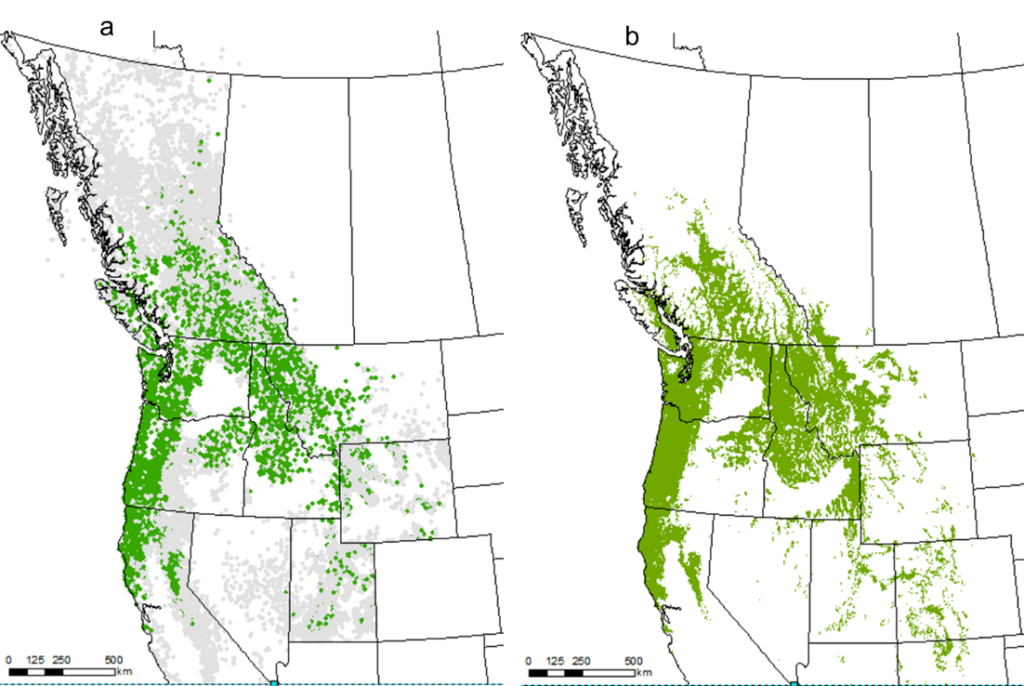
A predicted current spatial distribution of the climatic niche may not match well with the current distribution of the species in some areas. Typically, the extent of the climatic niche is greater than the observed range of the distribution. It may not suggest that the model is wrong; instead, it indicates that those areas are potentially suitable for this species to be there. This phenomenon is probably attributable to physical barriers to migration or human disturbances.
4.2. Provenance trials based modeling
Provenance trails in forest trees are traditionally used to determine optimal seed sources for reforestation. Populations collected from a wide range of environments (provenances) are tested in field common-garden experiments under one or multiple planting sites spanning a range of climatic conditions. These materials are now widely used to explore among-population variation along climatic gradients (i.e., genecology functions) and responses of populations to climatic conditions (i.e., response functions). The latter can be used to model the climatic niche at both the population and the species levels.
A response function can be developed for an individual population. Response functions are used to predict the response of adaptive traits including growth and survival to climate. The range of the climatic conditions suitable for the population can be used to define the climatic niche of the population. When individual response functions are integrated, it can be used to model the climatic niche of the species.
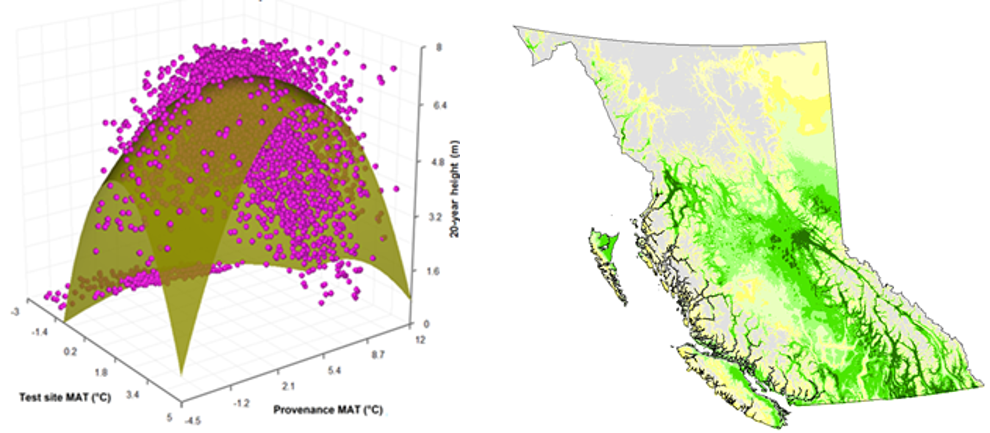
Since the trees growing in the common-garden experiments are free from interspecific competitions and the limit of migration, the climatic niche predicted by a response function can be considered as the fundamental niche of the population or the species. This will be discussed in detail later.

By Tongli Wang, Climate Modelling and Forest Applications is licensed under Creative Commons <CC BY-NC-ND 4.0> License

